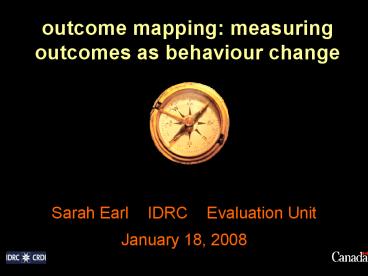outcome mapping: measuring outcomes as behaviour change - PowerPoint PPT Presentation
1 / 26
Title:
outcome mapping: measuring outcomes as behaviour change
Description:
outcome mapping: measuring outcomes as behaviour change. Sarah Earl IDRC Evaluation Unit ... Multidirectional. Not controllable. keeping your eyes wide open ... – PowerPoint PPT presentation
Number of Views:119
Avg rating:3.0/5.0
Title: outcome mapping: measuring outcomes as behaviour change
1
outcome mapping measuring outcomes as behaviour
change
Sarah Earl ? IDRC ? Evaluation Unit January 18,
2008
2
- key evaluation challenges
- measuring development results of research
- establishing cause effect in an open system
- timing
- encouraging iterative learning
- clarifying values
3
connecting research to well-being
8-15 Years
4
focus of outcome mapping
Behavioural Changes
5
outcome mapping key messages
6
looking at the bigger picture
- Seeing yourself as a part of a interconnected web
of relationships and systems
7
recognizing that change is
- Continuous
- Complex
- Non-linear
- Multidirectional
- Not controllable
8
keeping your eyes wide open
- Being attentive along the journey is as
important as the destination
9
contribution not attribution
- your influence on a better world
- you can influence but not control change in your
partners
10
evaluation to support innovation
11
the possibilities of ME with OM
Boundary Partners
Program
Relevance Viability (of the program)
Outcomes (behaviour changes in the partners)
Implementation (interventions by the program)
12
within their context
Behaviour Changes
Program
13
how do you evaluate outcomes?
14
why focus on behaviour changes?
- To stress that development is done by and for
people - To illustrate that although a program can
influence the achievement of outcomes, it cannot
control them because ultimate responsibility
rests with the people affected
15
focus on direct partners
- Key concept is boundary partners
- The individuals, groups, and organizations you
work with directly and anticipate opportunities
for influence
16
boundary partners have boundary partners
Boundary partner of your boundary partner
your boundary partner
17
progress markers
- A graduated set of statements describing a
progression of changed behaviours in the boundary
partner - Describe changes in actions, activities and
relationships leading to the ideal outcome - Shows story of change by articulating the
complexity of the change process - Can be monitored observed
- Permit on-going assessment of partners progress
(including unintended results)
18
progress markers ladder of change
Love to see
Like to see
Expect to see
19
(No Transcript)
20
outcome journal
- To understand the change process in boundary
partners. Collects information about - Story of change and reasons for change
- Unexpected changes
- The actors and factors that contributed to that
change - How we know the change occurred
- Learnings (what? how? why?)
21
major issues
22
baseline
- isnt only a measurement problem but a knowledge
issue - necessary to have a deep understanding of the
starting point - Step 0 is being developed (situational
analysis) - be wary of potential rigidness of baseline
- choose extent of documentation
23
sampling
- if you have many boundary partners you may have
to sample - quantitative or qualitative sampling strategies
24
principles of use
- Flexible modular to be adapted to use context
- Complementary use with other methodologies.
- Participatory seeks dialogue and collaboration
with partners - Evaluative thinking culture of reflection,
results oriented thinking, and promotes social
organizational learning
25
expanding accountabilities
- Using OM for ME can help you
- manage multiple accountabilities (up, down,
internal, horizontal) by - being able to document communicate outcomes
(traditional understanding of accountability) - engage in social learning with your boundary
partners making you more accountable to yourself,
your organization, and them
26
Thank you! For more information, examples of
use and to share your experienceswww.outcomemap
ping.ca www.idrc.ca/evaluation































